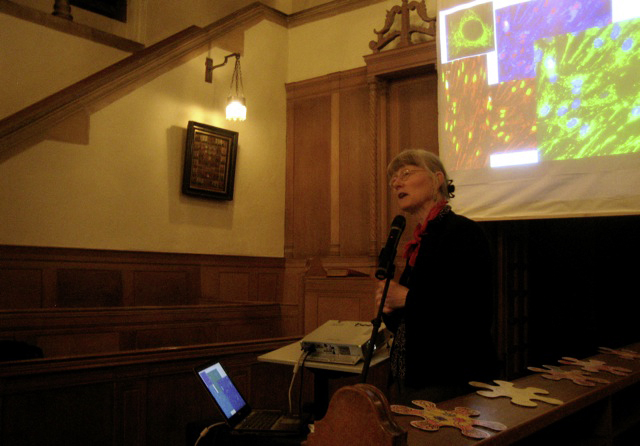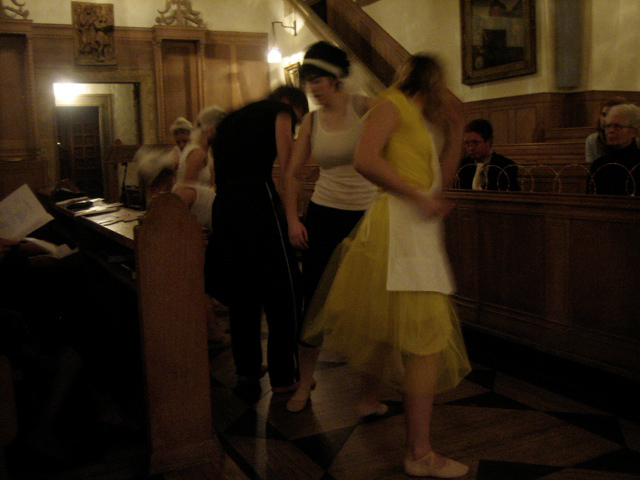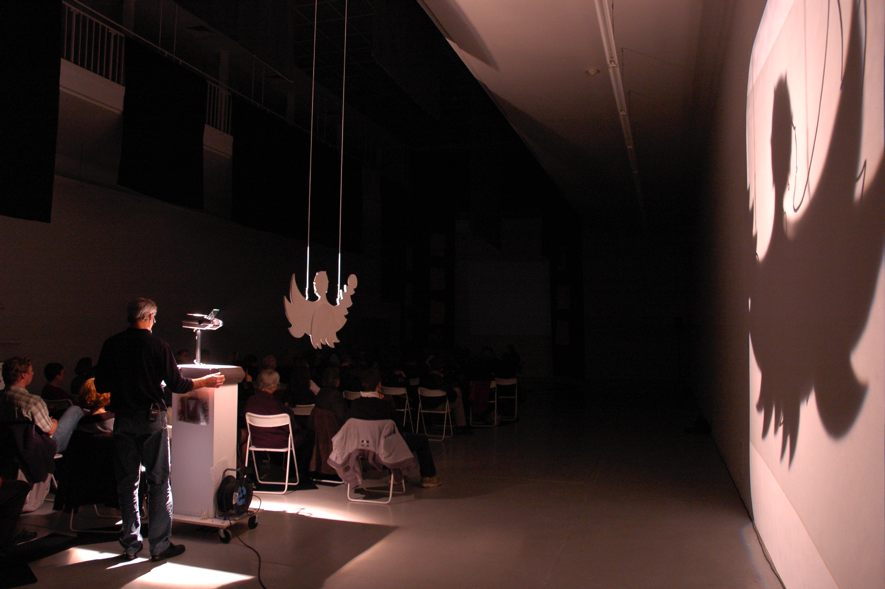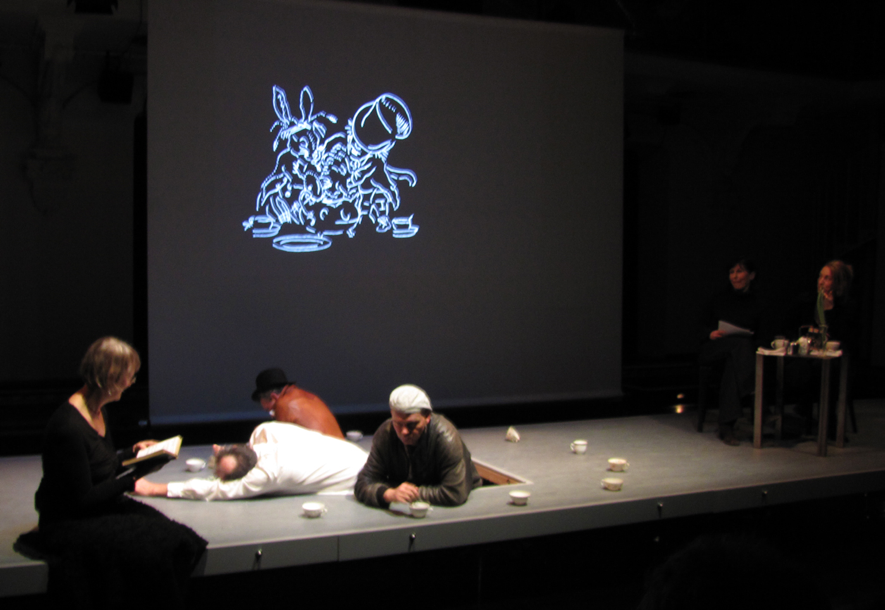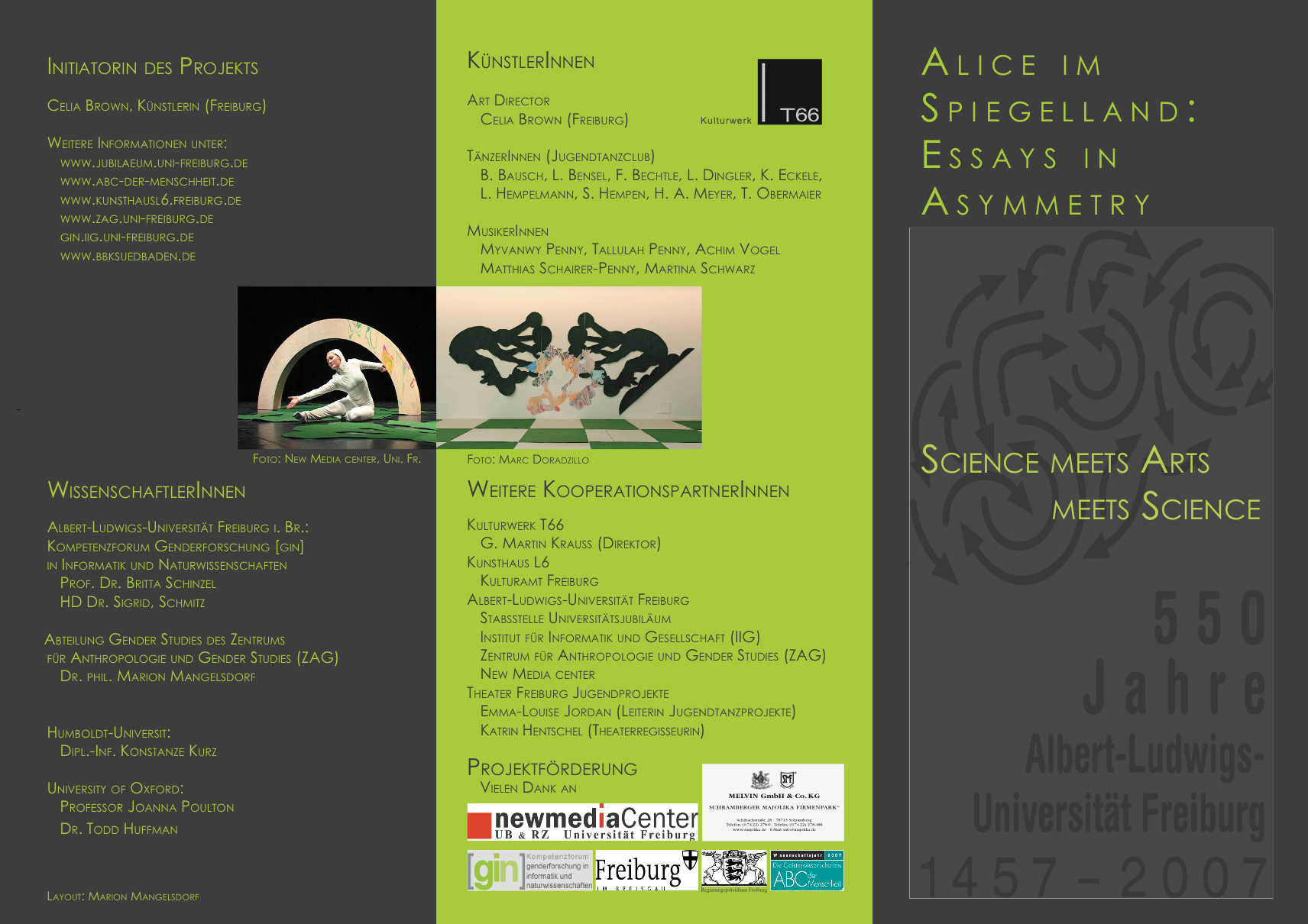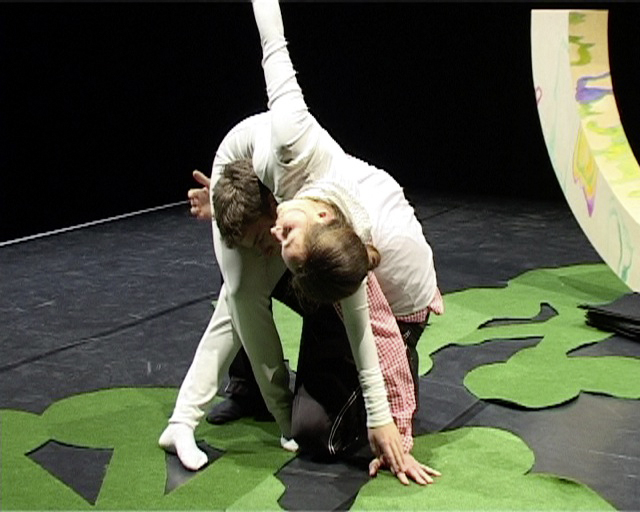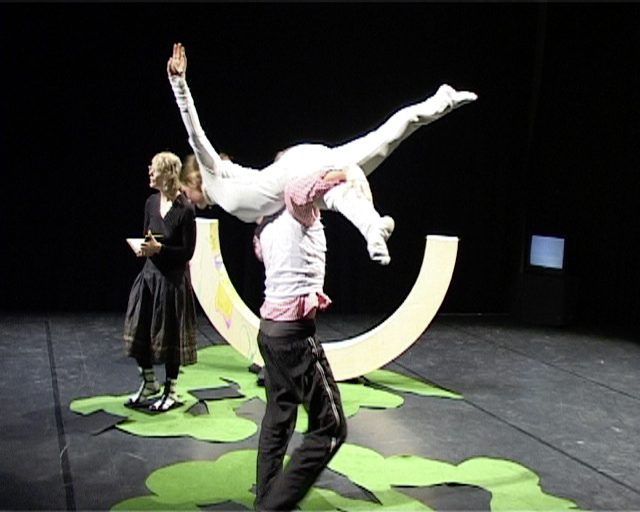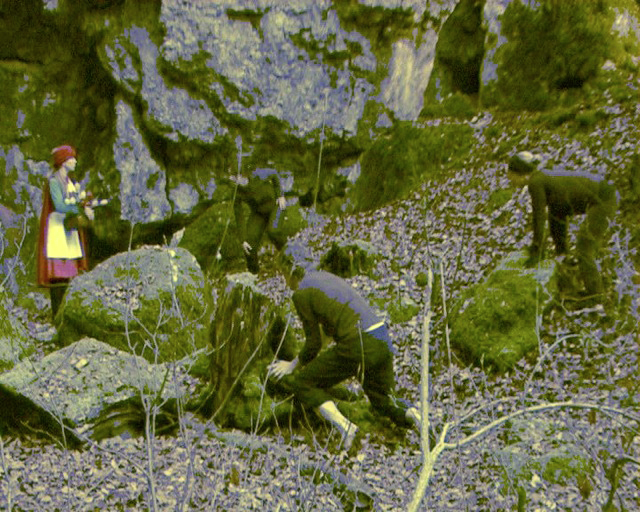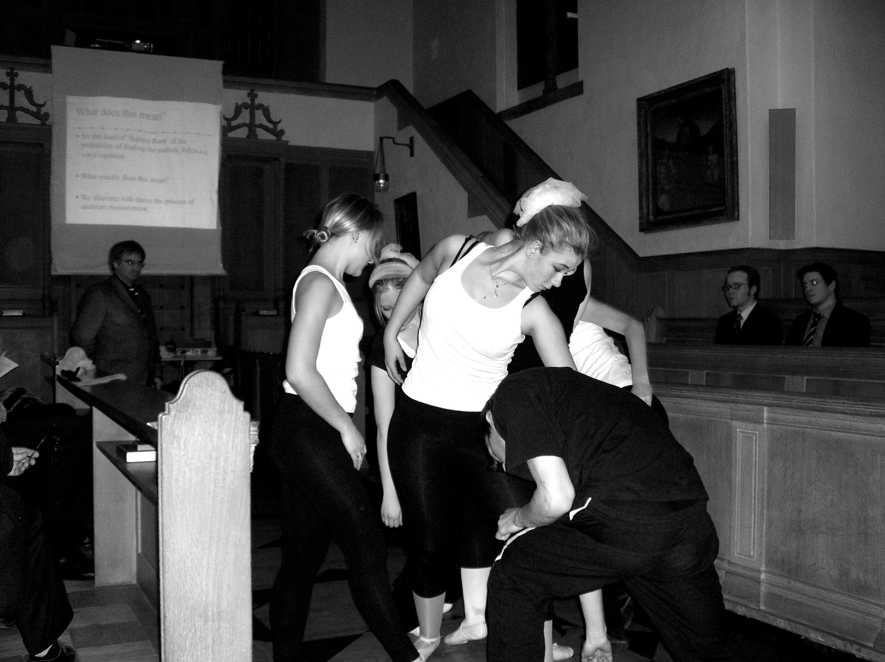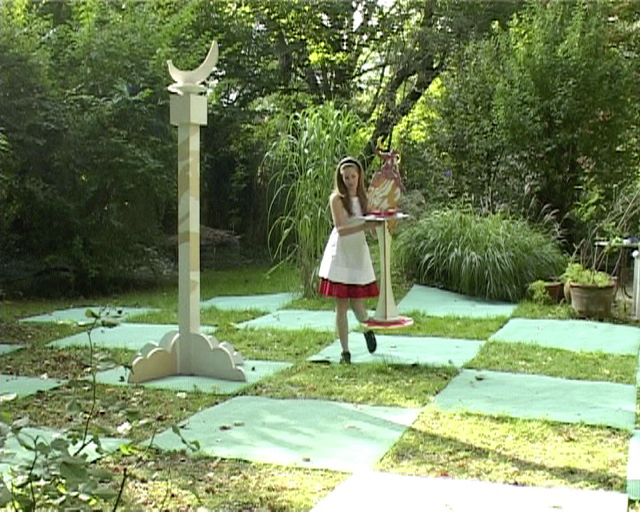lecture performances
My school education was slanted towards the natural sciences following in my parents’ footsteps, but I soon rebelled and took an interdisciplinary degree at Oxford, which included social science. While conducting research on homelessness for my PhD in Sociology at the LSE I started to attend painting classes and was able to gain a place at the art school in Frankfurt. For several years, I concentrated on painting, but the urge to integrate my previous interests finally led me to start collaborations with several scientists from Oxford and Freiburg universities, as well as dancers and filmmakers. Ovid’s Metamorphoses and Lewis Carroll’s Alice in Wonderland & Through the Looking-Glass inspired surreal worlds where these disparate people could all meet and suspend their professional antagonisms.
Inspired by Alice in the Chapel, Lady Margaret Hall, Oxford 2008
‘Curioser and curioser!’ cried Alice. Scientists, artists, dancers and musicians involved in our arts-science project are exploring the curious and even counter-intuitive in current scientific endeavour. What better place to combine our creative talents than in the fantastic worlds of Lewis Carroll?
Lewis Carroll: „Well, in our country,“ said Alice, still panting a little, „you’d generally get to somewhere else — if you run very fast for a long time, as we’ve been doing.“
„A slow sort of country!“ said the Queen. „Now, here, you see, it takes all the running you can do, to keep in the same place. If you want to get somewhere else, you must run at least twice as fast as that!“
Inner Beauty – Mitochondrial Dynamics
in the Chapel, Lady Margaret Hall, Oxford 2008
lecture: Professor Joanna Poulton
TänzerInnen: Lisa Bensel, Frederik Bechtle, Katja Eckeler, Laura Hempelmann, Sjaan Hempen, Thomas Obermaier (Mitochondrien), Freiburg
Kamera: Micheal Ott
TänzerInnen: Frederik Bechtle, Ceri Brenner, Karla-Luise Herpoldt, Rodina Peachey, Emily Wright, (Mitochondrien), Oxford
Choreographie: Emma-Louise Jordan
Musik: George Chambers
VoxNox: Laurel Braddock, Adele Foster, Geoffrey Lim, Suzie Sheehy, Bianca Summons, Ben Wingfield
Fotos: Neil Ashley, David Chan, Antonella Viola, Ruby Lamboll, Maya Evans
Observation of organic cells under the microscope in recent years has produced novel images that demand new interpretations. Mitochondria, the power houses within cells with their own DNA, can no longer be regarded as individual, static threads or little ‘sausages’ but appear as a electrically charged networks that are constantly splitting and joining.
The Chapel becomes a neuron stretching from brain to toe – a very long cell. The mitochondria have over a metre to travel in order to supply energy to the organist’s foot. The dancers represent loss and gain of energy through their movements, they cluster in groups and leap out ready and renewed.
The Mitochondria’s Dream – Der Traum der Mitochondrien
Kunstverein Freiburg 2003
mit: Celia Brown, Professor Joanna Poulton, Joan Brüggemeier, Fiona Grudszus, Annette Merkenthaler Rüdiger Nolte, Robin Stockitt
Veranstalter: Dorothea Strauss und Jens Galler vom Kunstverein Freiburg
Lesung: Judith Fehrenbacher, Christian Schäffer
Fotos: Marc Doradzillo
Video / Kamera: Axel Schäffler
Video / Schnitt: Dagmar Kamlah
Mitochondrien sind kleine Kraftwerke. Sie befinden sich in allen lebenden Zellen und besitzen ihre eigene DNS. Celia Brown hat ihren Vortrag „Der Traum der Mitochondrien“ genannt, als ob Mitochondrien von ihrer Vergangenheit träumen könnten. Bildbeispiele, Schattenwürfe, Objekte, zwei Sprecher: Am Aufbau der Metamorphosen von Ovid angelehnt erleben die ZuschauerInnen die Mitochondrien durch eine Reise in 15 Teilen.
Soiree zu Alice
Theater im Marienbad, Freiburg 2013
mit: Celia Brown, Ensemble Theater im Marienbad
Veranstalter:
Lesung: Celia Brown
Fotos:
Psyche and Alice
The fall of Alice also follows the trajectory of the tale of the beautiful Psyche, who fell from a mountaintop and eventually married her ‘beastly’ Amor. Psyche’s story is taken up again at the Mad Tea-Party.
Alice in the Mirror – Alice im Spiegelland
550-year jubilee, University of Freiburg, 2007
Art Director / Initiatorin: Celia Brown
TänzerInnen: Jugendtanzclub: B. Bausch, L. Bensel, F. Bechtle, L. Dingler, K. Eckele, L. Hempelmann, S. Hempen, H. A. Meyer, T. Obermaier
MusikerInnen: Mywanwy Penny, Tallulah Penny, Achim Vogel, Matthias Schairer-Penny, Martina Schwarz
Fotos: Marc Doradzillo, New Media Center (Uni Freiburg)
WissenschaftlerInnen
Prof. Dr. Britta Schinzel, Albert-Ludwigs-Universität, Freiburg
HD Dr. Sigrid Schmitz, Albert-Ludwigs-Universität, Freiburg
Dr. phil. Marion Mangelsdorf, Albert-Ludwigs-Universität, Freiburg
Dipl. Inf. Konstanze Kurz, Humboldt-Universität, Berlin
Prof. Joanna Poulton, University of Oxford
Dr. Todd Huffman, University of Oxford
Alice im Spiegelland (Hg. Celia Brown & Marion Mangelsdorf) 2012
Alice in Mirrorland was conceived by scientists and artists within the context of a collective initiative entitled Science meets Arts meets Science and developed into a ‘total art work’. The topics – the six impossible things Alice thought before breakfast – are brought into focus in Lecture Performances, as we have called our presentations: mirror images and their asymmetry in current debates concerning nature – the body – and culture are addressed in a dialogue between cultural anthropologists, representatives of the arts – fine art, theatre, music and dance – the neuro- and molecular-sciences, informatics and physics.
The artist Celia Brown, for whom such adventures are an integral aspect of her art practice, collaborated with academics and other artists to launch this project at the 550 jubilee of the Albert Ludwig University of Freiburg in 2007. Alice in Mirrorland was framed by an exhibition of the same name that took place at the municipal gallery of Freiburg Kunsthaus L6. Six Lecture Performances were presented in a lecture hall at the university parallel to the show, from 20 June to 25 July, and these formed the basis of the book Alice im Spiegelland eds. Celia Brown & Marion Mangelsdorf, Bielefeld:transcript 2012
Alice in Brainland
E-Werk, Freiburg (Kunst im Kopf Symposium), 2005
Lecture: Prof. Sigrid Schmitz
TänzerInnen: Frederik Bechtle (Weißes Kaninchen), Larissa Dingler (Raupe)
Choreographische Beratung: Emma-Louise Jordan
Lesung: Celia Brown
Musik: Achim Vogel
Kostüme: Kim Schimpfle
Video / Kamera / Betreuung: New Media Center, Universität Freiburg
Lewis Carroll: „Who are you?“ said the Caterpillar.
Alice enters the land of metamorphoses and shifts in perception. A scientific sketch of brainland conducted as a conversation on video between Sigrid Schmitz and Celia Brown is interrupted by dance interludes performed within an artificial brainland on stage. The collage is completed by quotations from the story of Alice in Wonderland delivered by Alice as a player in the performance.
Alice and the Wolf
Lecture: Dr. Marion Mangelsdorf, University of Freiburg, 2007
Video: Celia Brown & Marion Mangelsdorf, shot in the Wolfschlucht near Kandern, Black Forest, 2007
TänzerInnen: Barbara Bausch (Alice/Rotkäppchen), Frederik Bechtle, Katja Eckeler, Laura Hempelmann, Sjaan Hempen, Helen Anna Meyer (Wölfe)
Choreographie: Emma-Louise Jordan
Musik: Myvanwy Ella Penny, Tallulah Penny, Matthias Schairer
Transport: Paul Meyer
Video / Kamera: Johannes Beyerle, Aljoscha Hofmann
Video / Schnitt: Aljoscha Hofmann
Video / Kamera / Schnittplatz: New Media Center, Universität Freiburg
Im Wald „in dem nichts einen Namen hat“ – in diesem Fall der Schwarzwald – verwandelt sich Alice in Rotkäppchen (Barbara Bausch) und trifft den Wolf. Ist der Wolf groß und böse, wird er sich als Rotkäppchens Oma verkleiden und sie auffressen? Nein, Alice bringt ihn als domestizierten Hund durch den Spiegel zurück.
In the wood ‘where nothing has a name’ Alice transforms into Little Red Riding Hood and meets a wolf. Is the wolf big and bad? Will it dress up as Red Riding-hood’s grandmother and eat her up? Not at all: Alice brings it back as a domesticated dog through the looking-glass.
Alice through a physics Looking-Glass: Die Welt im Spiegel
University of Freiburg 2007, Lady Margaret Hall, Oxford 2008
„Antimatter Alice in a Chesspiece-piece“, Lady Margaret Hall, Oxford 2013
Lecture: Prof. Todd Huffman
Technische Beratung: Helen Rose Wilson
TänzerInnen: Frederik Bechtle, Lisa Bensel, Katja Eckeler, Sjaan Hempen, Thomas Obermaier (Quantenwelle), Freiburg
Choreographie: Frederik Bechtle, Emma-Louise Jordan, Freiburg
TänzerInnen: Frederik Bechtle, Ceri Brenner, Karla-Luise Herpoldt, Rodina Peachey, Claire Thomas, Emily Wright, Oxford
Choreographie: Ceri Brenner, Celia Brown, Todd Huffman, Oxford
Musik: George Chambers
VoxNox: Laurel Braddock, Adele Foster, Geoffrey Lim, Suzie Sheehy, Bianca Summons, Ben Wingfield
Antimatter Alice dances in a chesspiecepiece as a quantum wave to a composition by George Chambers. The dancers take on the task of representing quantum states, travelling through space as a fluid group. The shape of this “wave” changes through time as the dancers make their own decisions about where to move. The physicist intervenes in order to demonstrate the result of a measurement on a quantum system. A Humpty Dumpty dance demonstrates why it should be impossible for time to go backwards in the quantum world. The dancers then separate into black and white chess pieces and make mirror image movements. When one figure meets its opposite, she or he lays down on the floor of the lecture hall. Finally, matter and antimatter cancel each other out leaving Alice and the scientist as the survivors.
Lewis Carroll: “Things flow about so here”
As the dancers move they represent the motion of the wave function which represents the probability of finding the particle rather than the motion of the particle itself. The process of measurement causes the wave function to collapse revealing the location of the particle. When matter and antimatter encounter one another, they annihilate in a burst of energy. The game of chess will be played to its ultimate conclusion: the creation of the Universe.
Alice im Spiegel – Kommunikation im Spiegel
Lecture: Prof. Sigrid Schmitz, Prof. Britta Schinzel, Dr. Celia Brown, Dr. Constanze Kurz
Schauspiel: Lisa Bensel (Alice), Traute Hensch (Weiße Königin), Britta Schinzel (Schwarze Königin)
TänzerInnen: Frederik Bechtle, Lisa Bensel, Sjaan Hempen (Körper/Seele/DNA von Alice) Helen Anna Meyer (Skelett)
Choreographische Beratung: Emma-Louise Jordan
Musik: Martina Schwarz (eigene Komposition)
Video / Schnitt: Aljoscha Hofmann
Video / Kamera / Schnittplatz: New Media Center Universität Freiburg
In “Mirrorland”, Britta Schinzel, Professor for Informatics, transforms into the Red Queen through the looking-glass and delivers her lecture in this role to the video camera. Armed with a chip-card and ruler, she marks out the squares of the chessboard. Alice moves across the squares and interprets the communication between head and a rebellious body-skeleton in a dance duet. Celia Brown and Sigrid Schmitz attempt to capture the meaning and interconnection of “I” and “Egg”. Meanwhile, Britta Schinzel and Constanze Kurz discover 6 impossible virtual things. Finally, the Red Queen sitting at her computer conducts the dance via a transponder which is apparently able to communicate with the RFID chip in the chip-card of the University of Freiburg.
